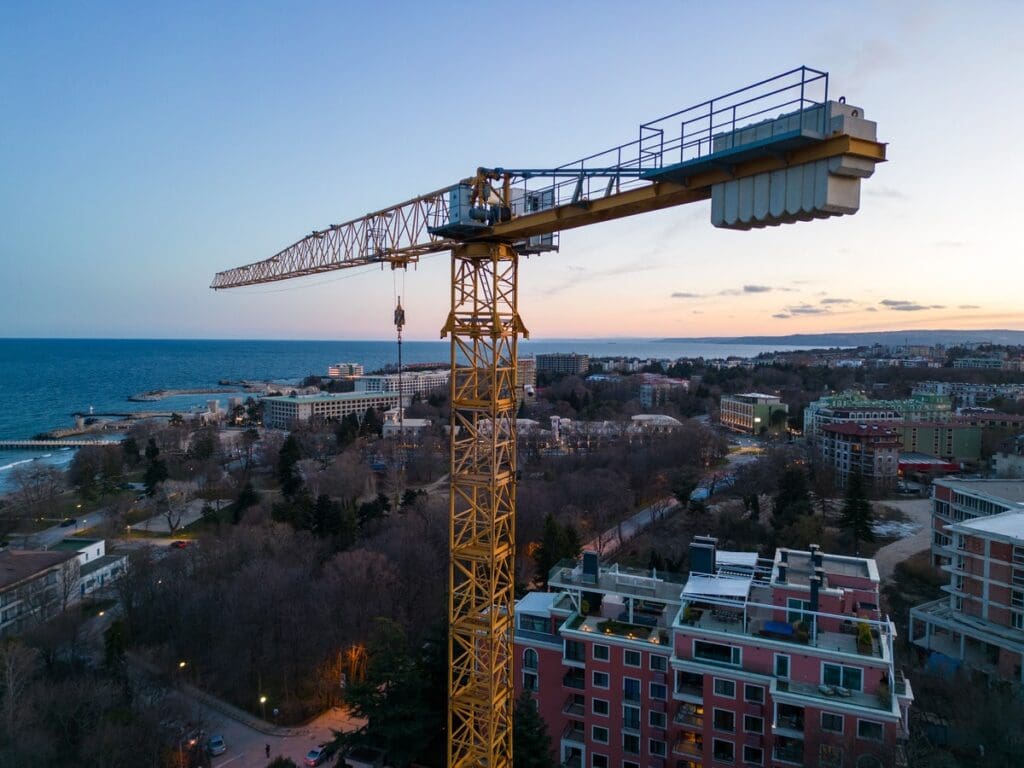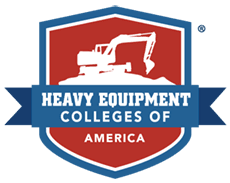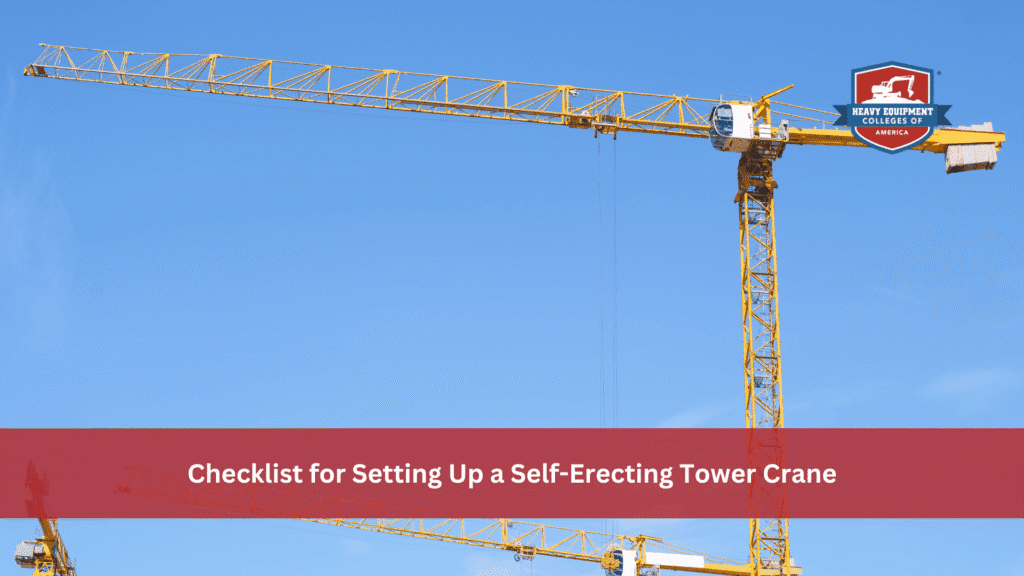As the name suggests, self-erecting tower cranes take some of the hassle out of assembling cranes the size of skyscrapers. However, every operator still needs to follow steps to keep themselves and others on the job site safe.
Want to learn more about setting up a self-erecting tower crane? At Heavy Equipment Colleges of America, we know the ins and outs of these tower cranes. We’ll go over the basic safety measures and protocols to follow to safely assemble these massive pieces of equipment.
Table of Contents
Checklist For Setting Up A Self-Erecting Tower Crane
Assembling one of these cranes takes precision and care, as well as a strict set of safety guidelines. These guidelines are in place to make the process as smooth as possible while preventing a serious workplace accident. A proper self-erecting tower crane setup checklist should include:

Start Your Crane Operator Career With Confidence
Kickstart Your Crane Operator Journey Today!
Hands-On Training | OSHA-Compliant Courses | Job-Ready Skills
Become a Certified Tower Crane Operator Today!
Start Enrollment ProcessFind The Right Location For You1. Pre-Arrival Planning and Documentation
Before the crane even arrives on the job site, you and your team need to take the proper steps to prepare the site. This helps the assembly process move smoothly with limited delays. Below we’ll go over some basic preparatory measures you can take.
Securing Permits and Paperwork
First and foremost, you and your team will need the proper work permits and documentation. This keeps your work site legal while preventing substantial fines and project delays.
Some of the paperwork you’ll need includes:
- Local Authority Permits
- Site-Specific Setup Plans
- OSHA Compliance Documents
- Insurance Verification
Evaluating the Job Site
Once you have the proper paperwork, you can begin inspecting the job site. The idea is to check the area for potential safety hazards and find the safest spot to assemble the tower crane. Look for safety concerns such as weak or unstable soil, nearby utility lines, and overhead obstructions.
2. Base Preparation and Foundation Setup
When the crane arrives on the site, it’s time to figure out the foundation. Look at the equipment as well as the site, and figure out the best position for the crane and how to best support it. Start from the ground up, and make sure your crane has a stable base and foundation to stand tall.
Ground Load and Foundation Requirements
A strong foundation keeps your crane secure and stable throughout the project. This all starts with the ground on which you build the crane. Check that the ground can hold the weight of the crane while also abiding by local standards for soil density. Also, make sure the ground is flat and even to keep the crane balanced.
Installing Base Supports and Stability Systems
In addition to the state of the ground, a self-erecting tower crane also needs a proper support system. This can include outrigger pads, a mat foundation, and proper pressure distribution. All of these things strengthen the base of the crane and keep it stable.
3. Safety Readiness Before Assembly Begins
Before you begin assembling your tower crane, you and your team will need to check the basic safety guidelines. These include equipment guidelines and staff qualifications. Both of these things ensure your job site follows required safety regulations and gets the job done properly.
Staff Qualifications and Safety Roles
Every team member needs the proper qualifications and skills to perform their role. From crane operation certifications to proper job site training, the right skills can set your team up for success.
You can also appoint one person on the team to be the safety officer and oversee proper safety procedures throughout the assembly process.
Checking Tools and Crane Components
Inspect the equipment and its components for wear and tear or signs of damage. Make sure everything is in order before you start putting the crane together. You should also check that you have all the tools and parts you need to assemble the crane properly.
4. Crane Setup: Assembly Process
Now that the job site is ready and the proper safety measures are in place, you and your team can begin assembling your self-erecting tower crane. Take your time during this phase, as attention to detail can make sure the crane is assembled safely and correctly.
Initial Setup Phase
Before you can start building up, you must first build the foundation. You and your team will need to properly position the base of the crane and connect the power system. Once you’ve checked that the power is working, you can check that the control system is ready to go.
Mounting the Tower and Attaching the Jib
The next step is to start mounting the tower and building up. Attach and secure each section of the crane, and then connect the horizontal arm (jib). From there, you and your team can set up the cable and pulley systems and test them for safety.
5. Balancing the Crane with Counterweights
Because these cranes are the height of skyscrapers, proper balance is vital in preventing them from tipping over. Make sure the counterweights match the crane’s specifications and install them in the proper order to keep the crane balanced. Your team should also double-check that the crane’s center of gravity is within the safe limits.
6. Final Testing and System Checks
Once the crane is assembled, it needs to prove it’s ready to go before your team starts lifting things. Your team should conduct a variety of tests and verifications to make sure every component is working properly and the crane is secure enough to start carrying supplies.
Conducting Load and Stability Tests
The first round of tests should be without a load; that way, you can check that the crane can move properly and is secure. From there, you can perform gradual load tests, slowly adding more weight and testing the crane’s functionality and stability.
Operational Verification
These tests check the tower crane’s operational systems, including motion controls, communication systems, and limit switches. All of these components need to work properly to keep crane operations smooth and safe.
Final Documentation and Handover
When you and your team are confident that the tower crane is stable and ready for use, it’s time for the final documents. These papers provide evidence that the equipment is ready for work and has been properly inspected for any safety concerns.
Inspection Documentation
You will need to fill out the proper documentation proving the equipment has passed initial safety inspections. These records can include testing documentation, safety inspection records, and a setup completion certification.
Be sure to keep a copy of all these documents in a safe place, as they are proof that you followed the proper assembly steps.
Operator Briefing
When handing the tower crane off to the operator on the job site, you’ll need to brief them on the equipment and the job site. These discussions should include the unique details of the job site, basic emergency procedures, and clear on-site communication protocols.
Start your Career with HEC Training Programs
Self-erecting tower cranes are crucial on any job site, especially projects that reach monumental heights. For these cranes to perform at their best, they need a strong foundation and proper safety precautions to improve efficiency and job safety.
Interested in becoming a tower crane operator? Heavy Equipment Colleges of America has an extensive catalog of heavy equipment programs that set you up for a successful career in the industry.
From mobile cranes to lattice boom cranes, we’ve got the right program for you. Give us a call today or visit our website to fill out an application.
Build a Strong Future in Heavy Equipment Operation
Train to Operate Self-Erecting Tower Cranes Safely and Confidently
Real-World Experience | Expert Instructors | Career-Focused Training
Enroll in Our Crane Operator Program Today!
Start Enrollment ProcessFind The Right Location For You
